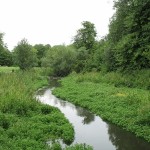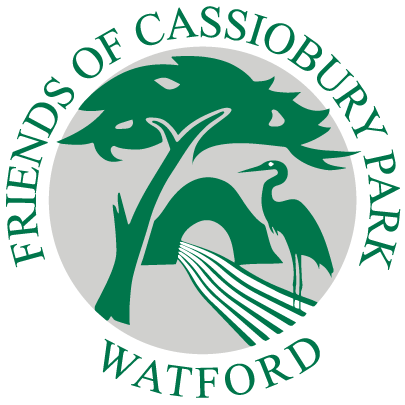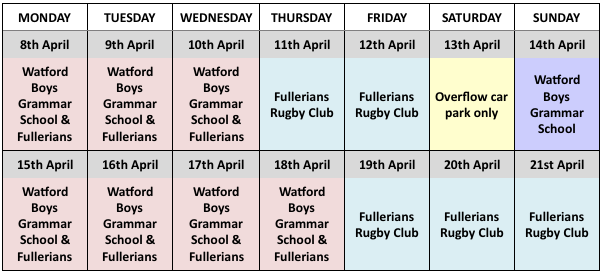Deep dark shade in the deep dark woods (we do need it this summer), but no gruffalos, in Cassiobury Park. The deep shade is under the horse chestnuts by the miniature railway line, as the canopies are now so dense. Instead of gruffalos we have triffids on the river margins – huge towering hogweed plants, flowers like chimney brushes, and reedmace with brown seed heads, like pokers. Each summer I write that they are taller than ever, but this year’s sunshine and rain have produced monsters.
 Imagine my surprise on July 11th, whilst walking alongside the river, downstream from the Meadow Bridge, when I heard the loud, protracted song of a reed warbler. It was very close by in the reedmace, which is not its usual habitat. Normally they nest in reed beds of Phragmites reeds and the closest, in my experience, are on the River Gade at Croxley Moor. After listening awhile, I glimpsed the bird fly, and the singing stopped. I rushed home to listen online, just to confirm the sighting. Later I’ve learnt that NR Warden Rob Hopkins was aware the bird was around.
Imagine my surprise on July 11th, whilst walking alongside the river, downstream from the Meadow Bridge, when I heard the loud, protracted song of a reed warbler. It was very close by in the reedmace, which is not its usual habitat. Normally they nest in reed beds of Phragmites reeds and the closest, in my experience, are on the River Gade at Croxley Moor. After listening awhile, I glimpsed the bird fly, and the singing stopped. I rushed home to listen online, just to confirm the sighting. Later I’ve learnt that NR Warden Rob Hopkins was aware the bird was around.
Another indicator of prolific plant growth this year is the sheer quantity of watercress growing in the sides of the river, leaving just a narrow fast flowing channel. Watercress – Nasturtium officinale , grows naturally in the chalk streams of S. Britain and is the oldest known leafy vegetable, packed with vitamins and minerals. Arlesford in Hampshire still has commercial beds and locally there is an excellent source in the Chess valley at Sarratt Bottom. (A fresh bag comes highly recommended by me – far superior to the supermarket produce.)Watercress belongs to the Cabbage family and once it has begun producing its small white flowers is apt to taste rather bitter. Fools watercress can easily be confused with the edible plant but is in the Carrot family (Umbellifer) so has completely different white flowers and serrated leaf margins.  Commercial production ceased in Cassiobury Park due to falling water levels, a decline in water quality, and the sheer labour intensity required to harvest it. Meanwhile the old beds have been left to silt up and have become an entirely different ‘carr’ habitat, currently supporting the invasive Himalayan balsam as our volunteers know to their cost…..The River Gade must be less polluted now as there are three large patches of common water crowfoot (Ranunculus aquaticus) anchored in the river bed, with long , branches and streaming leaves being tugged downstream. They are between the two weirs just down from Meadow Bridge, and the day I spotted them, three mallards were busy pulling at it to feed. Let’s hope by next year they will be well enough established to put up aerial stalks with white buttercup flowers, as they used to, just upstream from Crowfoot Bridge.
Commercial production ceased in Cassiobury Park due to falling water levels, a decline in water quality, and the sheer labour intensity required to harvest it. Meanwhile the old beds have been left to silt up and have become an entirely different ‘carr’ habitat, currently supporting the invasive Himalayan balsam as our volunteers know to their cost…..The River Gade must be less polluted now as there are three large patches of common water crowfoot (Ranunculus aquaticus) anchored in the river bed, with long , branches and streaming leaves being tugged downstream. They are between the two weirs just down from Meadow Bridge, and the day I spotted them, three mallards were busy pulling at it to feed. Let’s hope by next year they will be well enough established to put up aerial stalks with white buttercup flowers, as they used to, just upstream from Crowfoot Bridge.
Moving on to a different area and habitat in the park – the grassland between the Gardens and Stratford Way paths, where life is buzzing. Bees and hover flies are working the rose bay willow herb flowers. Grasshoppers are stridulating noisily amongst the grasses, meadow brown butterflies and orange gatekeepers are feeding and laying eggs. Sharp yelps and yaffles can be heard as juvenile green woodpeckers (brownish barred feathers) fly between the grass and the trees, staying in touch with their parents.  The hay meadow policy of cutting quite late is allowing all the flowering plants to get well established and shed seed for next year – harebells, sorrel, plantain, hawk-bits and ragwort. Also there is a plant I only spotted a few years ago called goatsbeard or Jack-go-to-bed-at- noon. It is a yellow daisy plant on a stiff stalk which only opens its flower on sunny mornings, and is definitely spreading around. The same is true in the damp/wet meadow in the NR. Where once there were small clumps of flowering plants, now there are large patches of species such as yellow rattle, fleabane, yellow flag iris, meadow sweet, hemp agrimony and yellow flag iris. Threading through amongst the grasses are climbers with tendrils – yellow and purple vetches, and scrambling through great willow herb and shrubs is bindweed with huge white trumpet flowers. Despite all out worries about flooding in the winter the reserve is flourishing.
The hay meadow policy of cutting quite late is allowing all the flowering plants to get well established and shed seed for next year – harebells, sorrel, plantain, hawk-bits and ragwort. Also there is a plant I only spotted a few years ago called goatsbeard or Jack-go-to-bed-at- noon. It is a yellow daisy plant on a stiff stalk which only opens its flower on sunny mornings, and is definitely spreading around. The same is true in the damp/wet meadow in the NR. Where once there were small clumps of flowering plants, now there are large patches of species such as yellow rattle, fleabane, yellow flag iris, meadow sweet, hemp agrimony and yellow flag iris. Threading through amongst the grasses are climbers with tendrils – yellow and purple vetches, and scrambling through great willow herb and shrubs is bindweed with huge white trumpet flowers. Despite all out worries about flooding in the winter the reserve is flourishing.
Elizabeth Gower 23rd July 2014





